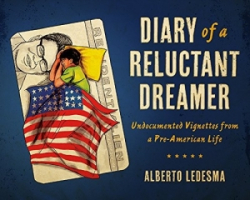Author Chronicles Lives of the Undocumented, Tells Dreamers Remaining Passive Not an Option
President Trump this week rescinded the Deferred Action for Childhood Arrivals (DACA) program, raising the possibility that many children of undocumented immigrants could be deported “back” to countries they’ve never known. And while Congress has six months to fix the problem, it has thrown the lives of these kids into a state of uncertainty.
It’s an uncertainty that author Alberto Ledesma knows well. He grew up in a family and community of undocumented immigrants. His upcoming book, Diary of a Reluctant Dreamer: Undocumented Vignettes from a Pre-American Life (Mad Creek Books), is reviewed in our September/October print edition. I thought he might have a few things to say about the news, and I was right.
Here, we talk about Dreamers, his unique storytelling method, and what it means to be a real American.
What was your reaction when you heard this week’s news about President Trump’s halt to the Deferred Action for Childhood Arrivals program?

Alberto Ledesma: "An undocumented student movement has emerged unlike anything we have ever seen in this country."
To be honest, I was not surprised. Those of us who have been working with “Dacamented” students, as I have at Berkeley for many years now, have been waiting for this for some time. Still, knowing that the decision was coming does not remove its sting. I was saddened by my continuing realization that the Trump administration has built its sense of authority by pushing the country more and more towards nativism.
Because undocumented immigration is an area that I have done research in, I know what a hot-button issue it has been for Republicans since the 1986 amnesty, a policy from which my family and I benefited. In the last ten years, however, an undocumented student movement has emerged unlike anything we have ever seen in this country. Students have been willing to confront elected officials in spite of their undocumented status. That activism is what led to the DACA policy.
Though the policy has been rescinded, I am very curious to see how students and their families react across the US. I know that in a way, that activism that will probably be coming, that possibly violent confrontation between ideological sides, is exactly what Steve Bannon has wanted. What he and others on his side label as “radical activism” are social actions that he and his wing of the Republican Party have often used to exacerbate a cultural war that they have been stoking since Trump was elected.
I have heard Bannon repeat many times in recent years that what he wants is to trigger a politics polarized by ethno-nationalism. Pitting an immigrant-pride movement against a Fox-news-idoctrinated aging white population that is itself not certain that “illegal aliens” should be getting any rights, which by the way they barely have themselves, would be a good way to achieve that goal. I was not surprised by the administration’s decision, but I am nervous about what will come of it.
What was your goal in writing Diary of a Reluctant Dreamer? Who is the intended audience?
Putting together my little book, as I call it, took many years. Over those years my goal was simply to give an embodied voice to an experience that is usually only presented sociologically or via statistics. I wanted to write and illustrate mundane stories focusing on what being undocumented in America means to me.
In a way, being undocumented is a kind of American experience, especially for immigrants who have been living in the US for years or decades. I wanted to share with a general audience all the vagaries of that experience, the worries and vanities of everyday undocumented life. In the end, I think that I only captured a tiny sliver of that life.
What do you say to those who do not consider Dreamers or the undocumented to be real Americans?
I would say that they are right because there are no “real Americans” per se. American identity as a concrete concept has been disputed since the creation of the nation. Just ask the Native Americans. Or, you could also just examine history, the work of Howard Zinn or Ronald Takaki, for example, to understand that Americanness has been a commodified ideal for hundreds of years. The Irish, Jews, Italians, and especially those who came from Asian countries were not readily accepted as Americans when they first immigrated en masse to the United States.
Being an American refers to a set of cultural practices and values that have evolved over time so that today we associate these to a particular people. But while Americans have always been multiracial and multicultural, the United States has also always had a social order built on historical racial privilege. This is the reason why most laypeople today associate “being an American” to being white, speaking English, and having an affinity towards materialism. It does not help that certain media outlets also reify an American ideal that is divorced from cultural and racial diversity.
Are you going to be lobbying Congress to reinstate DACA?
The best way that I can advocate for undocumented students is to continue doing my work as an illustrator, writer, and educator. I am too much of a novice to be effective in the political realm. I can write letters and make calls. At the end of the day, that energy may best be used in writing a story or drawing a scene that illustrates what undocumented life is about.
You have a unique method of storytelling, through single-panel drawings and text that encapsulate ideas or emotions. Where does that come from?
While I grew up a big fan of DC and Marvel comics, I was also always attracted to political cartoons, particularly the work of Jose Guadalupe Posada. Because I also tend to share my drawing via Facebook, the single panel lends itself best over the sequential frames approach. My goal is to try to generate as much narrative tension in one image as possible so that the viewer gets the idea as quickly as possible.
I was trained as a literary critic and a creative writer; yet, what I have found in using illustrations to convey a story is narrative flexibility. In creative nonfiction and short stories there are strict conventions dictating how a story should be relayed. Single-panel illustrations have allowed me to have a first-person and omniscient narrator at the same time without jarring the viewer too much. Breaking down that fourth wall has allowed me to tell my story while illustrating moments that are not part of my own life. It works well and that is why I use it so much.
What advice do you have for any Dreamers out there now?
I would say—don’t lose hope. Keep working hard and things will work out. I would point to California in the early 1990s to show that good can come from apparent hopeless situations. Soon after Reagan’s 1986 Amnesty, older and more conservative Californians became so incensed by all of these previously undocumented immigrants coming out of the shadows that they came together and, with Pete Wilson’s leadership, passed Proposition 187, a law meant to deny undocumented immigrants and their children access to any California social program. The law motivated previously undocumented immigrants to become citizens as soon as possible.
Since then, it has been these new voters who have given the mostly-Latino California Democratic Party its power. Now California leads the nation as an immigrant-friendly state. I don’t know if this same phenomenon will happen nationally. What I do know is that remaining passive is not an option. Though you might not be able to vote you can still advocate for your community and lobby for more humane policies. Put one foot in front of the other and work to make the change you want. At the end of the day, that is the only way that it will take place.

Howard Lovy is executive editor at Foreword Reviews. You can follow him on Twitter @Howard_Lovy
Howard Lovy
